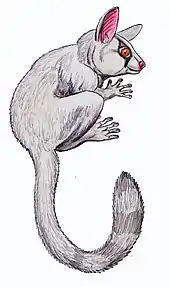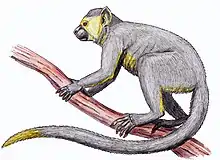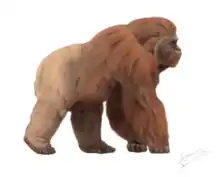| Rukwapithecus Temporal range: | |
|---|---|
| Scientific classification | |
| Domain: | Eukaryota |
| Kingdom: | Animalia |
| Phylum: | Chordata |
| Class: | Mammalia |
| Order: | Primates |
| Suborder: | Haplorhini |
| Infraorder: | Simiiformes |
| Superfamily: | Hominoidea |
| Family: | †Dendropithecidae |
| Subfamily: | †Nyanzapithecinae |
| Genus: | †Rukwapithecus Stevens et al., 2013 |
| Species: | †R. fleaglei |
| Binomial name | |
| †Rukwapithecus fleaglei Stevens et al., 2013 | |
Rukwapithecus fleaglei, the only species of the genus Rukwapithecus, is a fossil primate. Known from a single lower jaw preserving four teeth, it is interpreted as the earliest hominoid, a member of the group that includes gibbons, humans, and other apes. It is known from the Nsungwe Formation of south-western Tanzania, which dates to just over 25.2 million years ago. This area has also yielded the early Old World monkey Nsungwepithecus. Phylogenetic analysis places it within the group Nyanzapithecinae, related to Rangwapithecus and Nyanzapithecus.[1]
References
- ↑ Stevens, Nancy J.; Seiffert, Erik R.; O'Connor, Patrick M.; Roberts, Eric M.; Schmitz, Mark D.; Krause, Cornelia; Gorscak, Eric; Ngasala, Sifa; Hieronymus, Tobin L.; Temu, Joseph (2013). "Palaeontological evidence for an Oligocene divergence between Old World monkeys and apes". Nature. 497 (7451): 611–614. doi:10.1038/nature12161.
This article is issued from Wikipedia. The text is licensed under Creative Commons - Attribution - Sharealike. Additional terms may apply for the media files.



